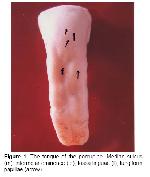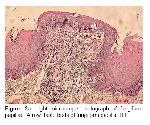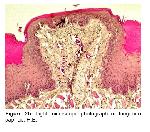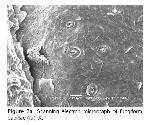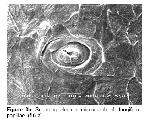It was reported that the median sulcus was present in the anterior part of the dorsal surface of the tongue in the rat
4 and Mouse
10. The present results indicated that the median sulcus was present both anterior and middle part of the tongue.
The investigators have pointed out that the fungiform papillae of guinea pig 14, rat 3,5-8 mouse 9,10 and flying squirrel 15 were densely located in the tongue tip and they were absent on the dorsal midline. In the opossum they were concentrated around the edges of the tongue. In the present study the fungiform papillae were absent both on the midline and on the tongue tip. They were scattered along both lateral edges of the dorsal surface in the middle one-thirds and they were common on the posterior one-thirds of the tongue. The pattern of distribution of fungiform papilla in the porcupine was different from that guinea pig, rat, mouse, flying squirrel and opossum.
Suggested that over 50% of the total number of fungiform papillae were located on the tongue tip (anterior quarter) in the rat 5. The results of the present study indicated that 33% of fungiform papillae were found on the anterior half of the tongue.
In rat 4,8, mouse 10 and hamster 13 each fungiform papillae had only a taste bud. In the opossum 16 and porcupine 18. They had no taste bud. In the present study, fungiform papillae generally had four or five taste buds.
Mistretta and Baum was found about 116 (6 months), 113 (twenty-four months) papillae per tongue in rats. On the other hand Miller and Preslar was found about 187 papillae per tongue in rats (93 papillae on the right sides and 95 on the left sides). While, Dinç et al. was found 115 (10 days) (59 papillae on the right sides and 56 papillae on the left sides), Mistretta and Oakley was found 119 (60 days) (61 papillae right sides and 58 papilla on the left sides) papillae per tongue identified 53 to 93 fungiform papillae per tongue in rats. These results were significantly different with present study.
The morphology of the fungiform papillae observed in this study was the different from that observed in other rodents.



